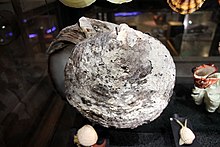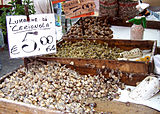
A pearl is a hard, glistening object produced within the soft tissue of a living shelled mollusk or another animal, such as fossil conulariids. Just like the shell of a mollusk, a pearl is composed of calcium carbonate in minute crystalline form, which has deposited in concentric layers. The ideal pearl is perfectly round and smooth, but many other shapes, known as baroque pearls, can occur. The finest quality of natural pearls have been highly valued as gemstones and objects of beauty for many centuries. Because of this, pearl has become a metaphor for something rare, fine, admirable and valuable.

Oyster is the common name for a number of different families of salt-water bivalve molluscs that live in marine or brackish habitats. In some species, the valves are highly calcified, and many are somewhat irregular in shape. Many, but not all oysters, are in the superfamily Ostreoidea.

Bivalvia, in previous centuries referred to as the Lamellibranchiata and Pelecypoda, is a class of marine and freshwater molluscs that have laterally compressed bodies enclosed by a shell consisting of two hinged parts. As a group, bivalves have no head and they lack some usual molluscan organs, like the radula and the odontophore. The class includes the clams, oysters, cockles, mussels, scallops, and numerous other families that live in saltwater, as well as a number of families that live in freshwater. The majority are filter feeders. The gills have evolved into ctenidia, specialised organs for feeding and breathing. Most bivalves bury themselves in sediment, where they are relatively safe from predation. Others lie on the sea floor or attach themselves to rocks or other hard surfaces. Some bivalves, such as the scallops and file shells, can swim. Shipworms bore into wood, clay, or stone and live inside these substances.

Gold, also called golden, is a color tone resembling the gold chemical element.

Pinctada is a genus of saltwater oysters, marine bivalve mollusks in the family Pteriidae. These pearl oysters have a strong inner shell layer composed of nacre, also known as "mother of pearl".

Baroque pearls are pearls with an irregular, non-spherical shape. Shapes can range from minor aberrations to distinctly ovoid, curved, pinched, or lumpy shapes. Most cultured freshwater pearls are baroque because freshwater pearls are mantle-tissue nucleated instead of bead nucleated. Cultured saltwater pearls can also be baroque, but tend to be more teardrop-shaped due to the use of a spherical, nucleation bead.

Cultured pearls are pearls which are formed within a cultured pearl sac with human intervention in the interior of productive living molluscs in a variety of conditions depending upon the mollusc and the goals. Having the same material as natural pearls, cultured pearls can be cultivated in seawater or freshwater bodies. Nowadays, over 95% of the pearls available on the market would be cultured pearls.

Rangiroa or Te Kokōta is the largest atoll in the Tuamotus and one of the largest in the world.

A fish hatchery is a place for artificial breeding, hatching, and rearing through the early life stages of animals—finfish and shellfish in particular. Hatcheries produce larval and juvenile fish, shellfish, and crustaceans, primarily to support the aquaculture industry where they are transferred to on-growing systems, such as fish farms, to reach harvest size. Some species that are commonly raised in hatcheries include Pacific oysters, shrimp, Indian prawns, salmon, tilapia and scallops.

Aquaculture in Australia is the country's fastest-growing primary industry, accounting for 34% of the total gross value of production of seafood. 10 species of fish are farmed in Australia, and production is dominated by southern bluefin tuna, Atlantic salmon and barramundi. Mud crabs have also been cultivated in Australia for many years, sometimes leading to over-exploitation. Traditionally, this aquaculture was limited to pearls, but since the early 1970s, there has been significant research and commercial development of other forms of aquaculture, including finfish, crustaceans, and molluscs.

Pinctada albina is a species of pearl oyster of the genus Pinctada, known as the sharks bay shell. Another common name is the Arafura shell. It is called the "Amami gai" in Japan.

Melo melo, common name the Indian volute or bailer shell, is a very large edible sea snail, a marine gastropod mollusc in the family Volutidae, the volutes.

The Tahitian pearl is an organic gem formed from the black lip oyster. These pearls derive their name from the fact that they are primarily cultivated around the islands of French Polynesia, around Tahiti.

Pteria sterna, or commonly known as the rainbow-lipped pearl oyster or the Pacific wing-oyster, is a species of marine bivalve mollusk in the family Pteriidae, the pearl oysters. This oyster can be found in shallow water along the tropical and subtropical Pacific coast of America, its range including Baja California, Mexico and northern Peru.

Pinctada mazatlanica is a species of tropical marine bivalve mollusc in the family Pteriidae, the pearl oysters. It is known by the English common names pearl oyster, Mazatlan pearl oyster, and Panama pearl oyster. Spanish common names include madre perla, and ostra perlifera panameña. This mollusc was first described to science in 1856 by conchologist Sylvannus Charles Thorp Hanley. Pinctada mazatlanica produces gem-quality pearls and was the basis of a pearling industry in the Gulf of California for centuries.
Pinctada fucata, the Akoya pearl oyster (阿古屋貝), is a species of marine bivalve mollusk in the family Pteriidae, the pearl oysters. Some authorities classify this oyster as Pinctada fucata martensii. It is native to shallow waters in the Indo-Pacific region and is used in the culture of pearls.

Pteria penguin, commonly known as the penguin's wing oyster, is a species of marine bivalve mollusk in the family Pteriidae, the pearl oysters. It is native to the western and central Indo-Pacific region and is used for the production of cultured pearls. The generic name comes from Greek πτερον (pteron) meaning wing.

Pinctada margaritifera, commonly known as the black-lip pearl oyster, is a species of pearl oyster, a saltwater mollusk, a marine bivalve mollusk in the family Pteriidae. This species is common in the Indo-Pacific within tropical coral reefs.
Pinctada longisquamosa, sometimes called scaly pearl osters, are a small species of pearl oyster found in the western Atlantic. They are distinguished by unique prismatic shell structures which protrude from the outer shell.

Molluscs play a variety of roles in culture, including but not limited to art and literature, with both practical interactions—whether useful or harmful—and symbolic uses.




















